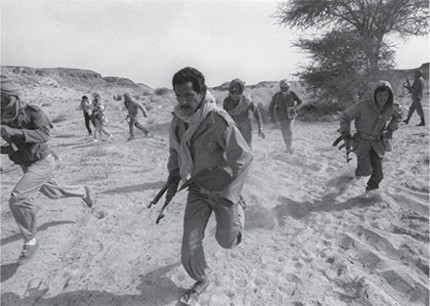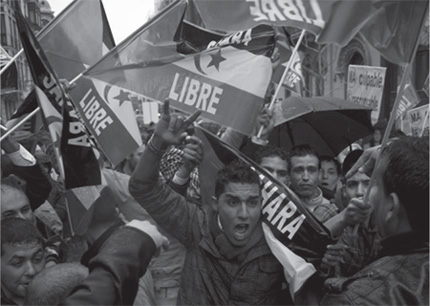

Western Sahara is a territory located on the Atlantic coast of northwestern Africa. Neighbouring Morocco claims the territory as its own, although that claim is not internationally recognized. A group of the Western Sahara’s indigenous inhabitants fighting for independence named the territory the Saharan Arab Democratic Republic and formed a government-in-exile in the 1970s.
Little is known of the prehistory of Western Sahara, although Neolithic (New Stone Age) rock engravings in Saguia el-Hamra and in isolated locations in the south suggest that it was occupied by a succession of hunting and pastoral groups, with some agriculturists in favoured locales, prior to a gradual process of desertification that began about 2500 BCE. By the 4th century BCE there was trade between Western Sahara and Europe across the Mediterranean; the Phoenicians sailed along the west coast of Africa in this period. The Romans also had some contact with the Saharan peoples. By medieval times this part of the Sahara was occupied by ṣanhajāh Berber (Amazigh) peoples who were later dominated by Arabic-speaking Muslim Bedouins from about 1000 CE.
In 1346 the Portuguese discovered a bay that they mistakenly identified with a more southerly Río de Oro, probably the Sénégal River. The coastal region was little explored by Europeans until Scottish and Spanish merchants arrived in the mid-19th century, although in 1476 a short-lived trading post, Santa Cruz de Mar Pequeña, was established by Diego García de Herrera, a Spaniard. In 1884 Emilio Bonelli, of the Sociedad Española de Africanistas y Colonistas (“Spanish Society of Africanists and Colonists”), went to Río de Oro bay and signed treaties with the coastal peoples. Subsequently, the Spanish government claimed a protectorate over the coastal zone. Further Spanish penetration was hindered by French claims to Mauritania and by partisans of Sheikh Mā’ al-‘Aynayn, who between 1898 and 1902 constructed the town of Semara at an inland oasis. Cape Juby (ṭarfāyah) was occupied for Spain by Col. Francisco Bens in 1916, Güera was occupied in 1920, and Semara and the rest of the interior were occupied in 1934.
In 1957 the territory was claimed by Morocco, which itself had just reached independence the previous year. Spanish troops succeeded in repelling Moroccan military incursions into the territory, and in 1958 Spain formally united Río de Oro and Saguia el-Hamra into a Spanish province known as Spanish Sahara. However, the situation was further complicated by newly independent Mauritania’s claims to the province in 1960, and in 1963 huge phosphate deposits were discovered at Bu Craa in the northern portion of the Spanish Sahara, which made the province a potentially economically valuable prize for any country that could firmly establish possession of it. Mining of the deposits at Bu Craa began in 1972.
Decades of social and economic change caused by drought, desertification, and the impact of the phosphate discoveries resulted in an increase in national consciousness and anticolonial sentiment. A guerrilla insurgency by the Spanish Sahara’s indigenous inhabitants, the nomadic Saharawis, sprang up in the early 1970s, calling itself the Popular Front for the Liberation of Saguia el-Hamra and Río de Oro (Polisario Front). The insurgency led Spain to declare in 1975 that it would withdraw from the area. Faced with consistent pressure from Morocco and Mauritania and itself undergoing a period of domestic uncertainty, Spain agreed to the partition of Western Sahara between the two countries despite a World Court ruling that Morocco’s and Mauritania’s legal claims to the Spanish Sahara were tenuous and did not negate the right to self-determination by the Saharawis. Morocco gained the northern two-thirds of the area and, consequently, control over the phosphates; Mauritania gained the southern third. Sporadic fighting developed between the Polisario Front, which was supported by and based in Algeria, and the Moroccan forces. In 1976 the Polisario Front declared a government-in-exile of what it called the Saharan Arab Democratic Republic (a government recognized by some 70 countries), and it continued to raid Mauritanian and Moroccan outposts in Western Sahara.
Mauritania bowed out of the fighting and reached a peace agreement with the Polisario Front in 1979, but in response Morocco promptly annexed Mauritania’s portion of Western Sahara. Morocco fortified the vital triangle formed by the Bu Craa mines, Laayoune, and Semara while the Polisario Front guerrillas continued their raids. A United Nations (UN) peace proposal in 1988 specified a referendum for the indigenous Saharawi to decide whether they wanted an independent Western Sahara under Polisario Front leadership or whether the territory would officially become part of Morocco. This peace proposal was accepted by both Morocco and the Polisario Front, and the two sides agreed to a cease-fire in 1991. As a UN administrative and peacekeeping force arrived in Western Sahara to prepare to conduct the referendum, however, Morocco moved tens of thousands of “settlers” into the territory and insisted that they have their voting qualifications assessed. This drawn-out procedure, which involved questions regarding the definition of who among the traditionally nomadic Saharawis would be entitled to cast a ballot, continued throughout the 1990s and into the early 21st century. Meanwhile, Morocco continued to expand its physical infrastructure in Western Sahara despite widespread protests against its presence in the areas under its control. Efforts to mediate the crisis also continued into the 21st century, including the 2009 approval by the UN Security Council for informal talks to take place between Morocco and the Polisario Front, after previous rounds of talks in 2007 and 2008 had been unsuccesful.

Polisario Front commandos run to take up positions during a June 1988 air raid drill. AFP/Getty Images

Protestors for Western Sahara independence at the European Union-Morocco summit in Granada, Spain, Mar. 7,2010. AFP/Getty Images
During this time the Polisario Front continued its campaign despite a number of setbacks. Among the challenges were defections from the organization and a reduction in support by its primary backer, Algeria, as that country was forced to concentrate on its own internal problems. Algeria’s diplomatic campaign on behalf of Saharawi self-determination, however, continued unabated. By 2001 tens of thousands of Western Saharans, including numerous Polisario Front soldiers, had relocated to semipermanent refugee camps in Algeria.